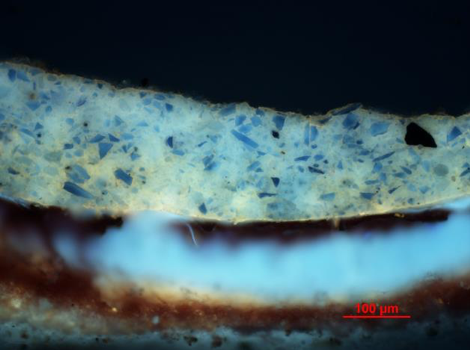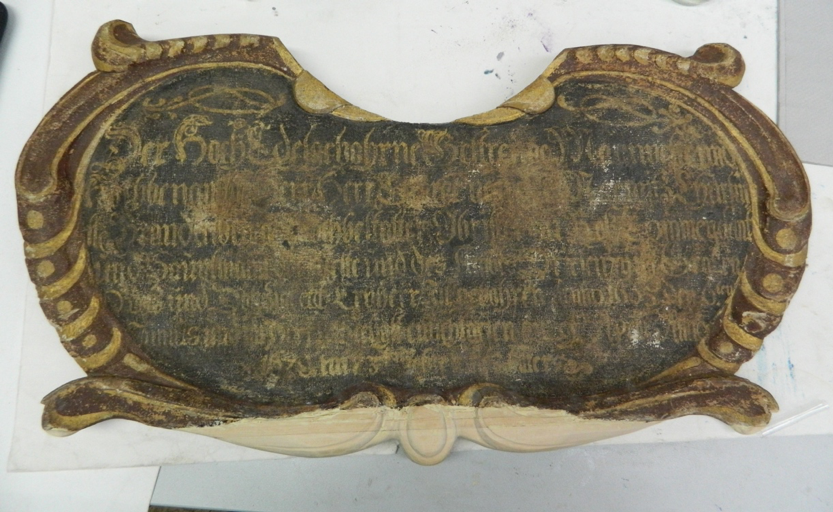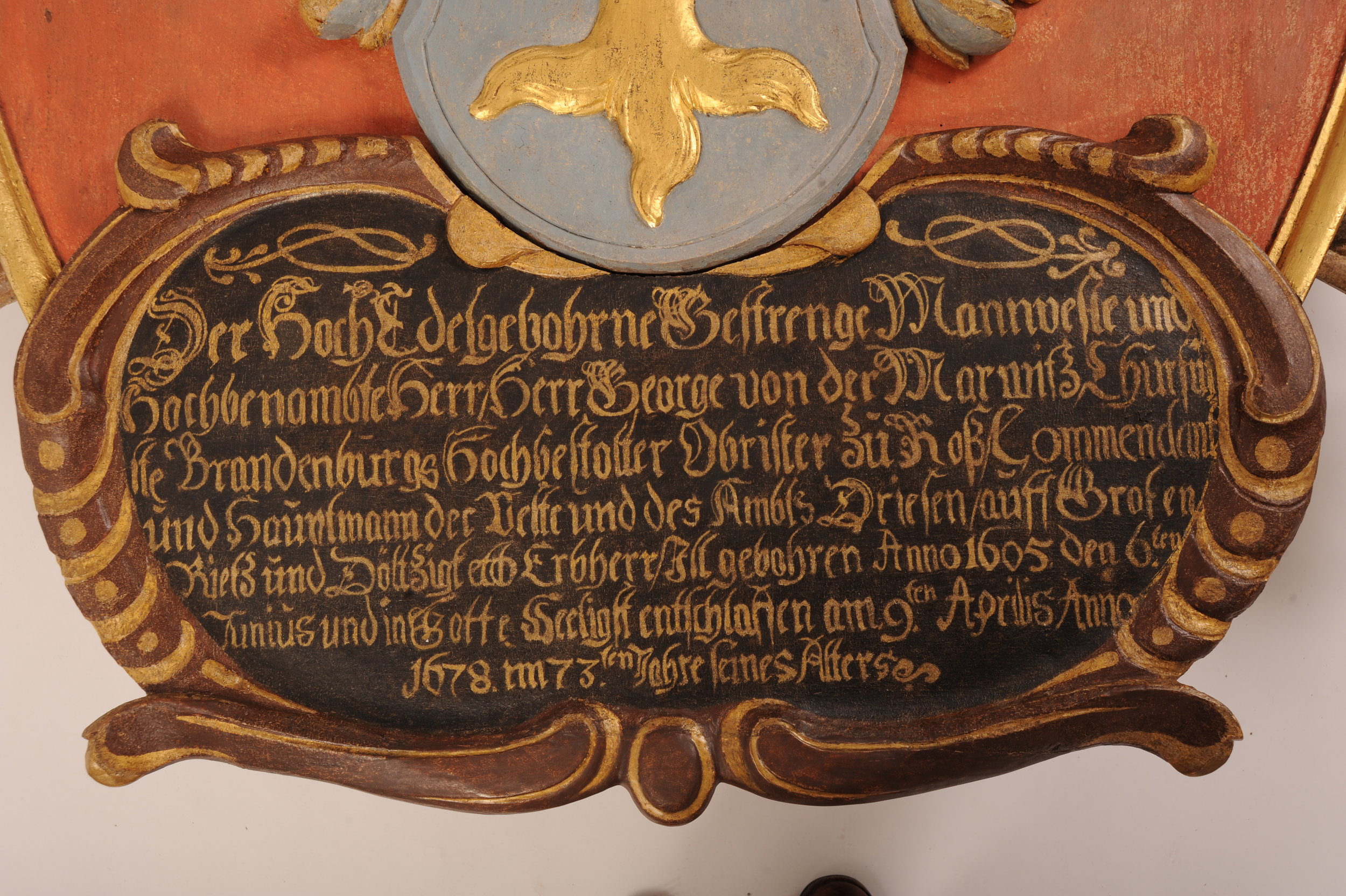Description, sociology and dating
The object in question is the hatchment of Georg von der Marwitz. The centre is formed by an oval shield carrying the plastically realised family coat of arms. Apart from the lower third the shield is framed by a corona of weapons, military equipment and flags.
The family coat of arms illustrates the legend of the origin of the family name. Once there was only one woman left carrying the name “von Marwitz” that was hence about to vanish. To avoid that she pried the emperor to let her first son carry the family name further but was only granted that he might carry the name “von der Marwitz”. This brave woman thus forms the heart of the family coat of arms, depicted as a maid with blonde hair wearing a yellow dress. She is surrounded by black wings forming the so called open vol. She is standing on a black helmet from which a lambrequin in blue and gold spreads to both sides. The necklace underneath the helmet is not of heraldic relevance (Walter, L. (1978). Das große Buch der Wappenkunst. Entwicklung, Bildmotive, Elemente, Gestaltung. München: Georg D. W. Callwey. P.113.). It also frames an escutcheon that sits under the helmet showing a leafless golden tree with a split crown on a blue background, that symbolises the family tree once to become extinct. All these elements of the family coat of arms are set onto a red oval shield framed by a golden moulding. A plaque with the following fragmentary inscription in gold on black ground that identifies the object the hatchment of Georg von der Marwitz is attached to the lower part of the shield:
„Der HochEdelgebohrne Gestrenge Ma [... ]
Hochbenambte Herr / Herr Georg von der Marwitz Churfür
st[e] Brandenburg[e] hochbestalter Obrister zu Roß Commen[t]ant und Hauptmann der Feste und des Ambts Driesen / [...] Grafen [...] und Dölzigt [...] / [...] gebohren Anno 1605 [...] 6.ten
Junius und [...] entschtorben am 9.ten Aprius Anno
1678 im 73ten Jahre seines Alters“
The inscription and the overall decoration of the hatchment carries great resemblance to the epitaph of Hans von der Marwitz who died in 1675. It has the same corona bristling with weapons as the one of Georg von der Marwitz which points towards a strong connection of the von der Marwitz to the military. The family of von der Marwitz belongs to the ancient nobility of the Brandenburg March thus the hatchment was located for several hundred years in the church of the castle Groß Rietz near Beeskow in Brandenburg that was built by the son of Georg von der Marwitz from 1693-1700 (http://www.vondermarwitz.com/2013-07-24-16-09-36/gross-rietz).
Given that the object is a hatchment the year of Georg von der Marwitz’ death, 1678, can be supposed as terminus post quem. Due to its provenance the hatchment is likely to have been made by the hand of a Brandenburg craftsman and belongs in the context of landed gentry.
Epitaph of Hans von der Marwitz
Construction and polychromy
The hatchment is 175 cm high, 145 cm wide and 17.5 cm deep.
The oval shield consists of two butt joined boards that are fixed by two dovetail battens. The corona is made of three boards that are nailed to the back of the shield, two of them lengthways, one sideways. The mould consisting of multiple pieces is butt glued to the shield. The carvings are carved out of a 3 mm thick board, more extensive parts are pieced on. The carvings are connected to the shield with treenails. The plaque is wrought out of one piece and also fixed to the shield with treenails.
The shield consists of pine wood (Pinus sylvestris L.) whilst the carvings are made of limewood (Tilia spec.) (The wood was determined microscopically based on Grosser, D. (1977). Die Hölzer Mitteleuropas. Berlin, Heidelberg, New York: Springer. ).
The hatchment is polychromed entirely. The layers of colour as well as the gilding were applied on top of a whitish grounding. The colour scheme of the shield and the family coat of arms consists of blue, red and yellow, respectively gold. The same colours were used for the corona although here beiges and browns were added to the scheme.
Damage
The constructional state of the hatchment was quite good, there were some shakes and open joints in the oval shield, the helmet and the lambrequin as well as patches of woodworm infestation holes that could also be found on the golden profile. In the area of the corona there was some loss. The joint of the plaque and the shield was loose, the lower part of it was broken off. These damages were caused by faulty handling.
The overall state of the surface was worse than the constructional one. Regarding the condition of the polychromy the hatchment had to be divided into two sections: The corona and the shield including the plaque.
Whilst the polychromy of the shield was in a relatively good state of preservation, the one of the corona was in quite a bad state. The polychromy was flaking or missing only in smaller areas on the shield. There was some loss in the paint layer of the open vol, the red background and the plaque on which it made the inscription almost unreadable. These damages seem to have been the result of abrasive cleaning and thus of faulty handling. Of the polychrome layers of the right and upper part of the corona the layer of paint as well as the gilding were almost entirely lost, on top of that the ground layers were delaminated and flaky in the upper part. This phenomenon was caused by adverse climatic conditions. In many areas the colour layer appeared dull which is caused by disintegration of the binder. The entire surface of the hatchment was heavily polluted due to having been kept in an inappropriate environment.
Cracks and loss in the polychromy allowed first insights concerning the structure of these as well as prior revisions. It was visible that on the whole object a white ground layer was applied, that can be assumed as being chalk ground. The dress of the maid used to be leaf gilded and was overpainted with yellow.
Mapping of the damages
Scientific examination of the surface
For means of determination of the structure and the composition of the polychromy ultraviolet light as well as microscopic analysis of sections of the layers and analysis of the solubility were employed. The examination delivered the following result:
Ultraviolet light (The ultraviolet lamp used: UVAHAND 250 GS Fa. Hönle, uv-technology, Gräfeling/München.) did not turn out to be revealing useful information as the fluorescence of the surface was overall quite inconclusive and did not support the spotting of retouches.
The microscopic analysis showed that the polychromy on the entire hatchment starts with an identic ground layer, a thick, light, protein bound layer (determined via dyeing with Ponceau-S-Red). On top of this layer there are two brownish-transparent barrier layers of which the lower, thicker one is protein bound, too. It is likely to be a light glue solution. On top of these barrier coats are the layers of paint or leaf gold. The dying of a sample of the blue paint of the lambrequin with rhodamine B suggests that it is oil bound. The analysis showed, apart from the maid’s dress no definite trace of a complete repainting, the visible polychrome layer thus can be seen as the original ones.
Microscopic examination of a cross-section sample of the polychromy of the lambrequin under VIS light
Cross-section sample under UV light, the blue fluorescence of the ground layer suggests it being protein bound
Cross-section sample under VIS light, the dying with Ponceau-S-red shows that the ground layer as well as the barrier layer is protein bound
Cross-section sample under UV light, the yellow fluorescence of the colour layer after dying with rhodamine B shows that it is oil bound
The analysis of the solubility showed that the different layers of paint and leaf metal have different solubilities. The blue paint of the lambrequin and the red background of the shield were resistant to aqua dist., ethanol, white spirit, isopropanol and shellsol T which aligns with the result of dying. The black paint of the wings is polar soluble therefore it can be only cleaned carefully dabbing. For the whole object fog damp cleaning with a Blitz-Fix suction block and warm distilled water showed the best results.
Restoration
The restoration of the constructional damages was dealt with first. The shakes and open joints were filled in with splints of wood according to the surrounding material. The splints were then evened out. Smaller shakes were filled in with Stuccokitt (wood putty). The splints were stained with walnut stain on the back. The loose joint of plaque and shield was fixed with new treenails. The losses in the corona were replaced with carvings in limewood. The loss on the lower part of the plaque was first evened out with little rods, the replacement was then carved in limewood. All replacements were primed with chalk ground and retouched with Mussini paint (oil-resin-paint) diluted with turpentine oil and mattified dammar varnish was used for all retouches, for the replenishment on the plaque ormolu was used additionally. For bonding hide glue (skin and bone 1:1) was used.
The first step to restore the polychrome layers of the hatchment was carefully dry cleaning the surface using a synthetic brush and a vacuum cleaner on a low setting. It was then fog damp cleaned with a Blitz-Fix suction block. The next step was to consolidate the loose polychrome layers that mainly in the corona formed leafy flakes. Big flakes were first dampened with a mixture of ethanol and aqua dist. (50/50), then rabbit glue (7%) was applied with a brush and the chips were pressed down with a rubber brush. Larger areas of flaky polychrome layers were sprayed with rabbit glue (7%), after settling for 45 minutes the flakes were pressed down with a heated spatula interleafing Hostaphan film. Loss in the ground layer was filled in with chalk ground. To secure the loose pigments caused by chalking of the colour layer as a result of the disintegration of the binder rabbit glue (7%) was sprayed on the entire surface. The rabbit glue also served as a barrier layer having a different solubility than the paint used for retouching. Loss in the colour layer was then retouched diaphanously with Mussini paint (oil-resin-paint). Loss in the gilding was treated depending on the area: On the maid’s dress, th tree and the profile leaf gold (“Orange Doppelgold”) was applied as an oil gilding using Charbonnel 12-h mixtion on top of a barrier coat of rabbit glue (7%). The gold was patinated with Mussini paint. In the corona and the lambrequin loss in the gilding was simply retouched using Mussini paint in ochre.
Lambrequin after cleaning
Lambrequin after consolidation and application of chalk ground
Lambrequin after retouch
Escutcheon after cleaning and application of chalk ground
Escutcheon after retouch and gilding
The retouch of the inscription of the plaque was a challenge, using a magnifying glass the slightest traces of gold were connected, the gaps filled in with ormolu. To determine the text, comparable objects were taken in consideration, one of them being the gravestone of Franz Felix Zialkovsky von Zialkovic located in the charnel house of Brno (CZ). The background was retouched with black Mussini paint. The result of hours of concentrated work was the following inscription again readable:
Der HochEdelgebohrne Gestrenge Mannveste und
Hochbenambte Herr / Herr George von der Marwitz Churfür
ste Brandenburgs hochbestolter Obrister zu Roß/ Commendant
und Hauptmann der Veste und des Ambts Drießen / auff Großen
Rietz und Dölzigt[...] Erbherr/ Ist gebohren Anno 1605 den 6.ten
Junius und in Gotte Seeligst entschlaffen am 9.ten Aprilis Anno
1678 im 73.ten Jahre seines Alters“
The plaque was airbrushed dammar with varnish to protect the inscription.
Click to reveal the result.
Frontal view of the hatchment before restoration
Hatchment, fully restored

















